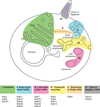The Rabs: a family at the root of metazoan evolution
- PMID: 22873178
- PMCID: PMC3414739
- DOI: 10.1186/1741-7007-10-68
The Rabs: a family at the root of metazoan evolution
Abstract
Eukaryotic cells are distinguished by their compartmentalization into membrane-enclosed organelles that exchange membranes and content in a highly ordered manner. Central in defining membrane identity are the Rabs, a large family of small GTPases that localize to distinct membranes and recruit specific regulators of membrane traffic. Two recent papers, including one by Klöpper et al. in BMC Biology, present phylogenomic evidence that the Rab repertoire was established very early in eukaryotic evolution, and correlates with interspecies variations in organelles.
Figures


Comment on
-
Untangling the evolution of Rab G proteins: implications of a comprehensive genomic analysis.BMC Biol. 2012 Aug 8;10:71. doi: 10.1186/1741-7007-10-71. BMC Biol. 2012. PMID: 22873208 Free PMC article.
Similar articles
-
Untangling the evolution of Rab G proteins: implications of a comprehensive genomic analysis.BMC Biol. 2012 Aug 8;10:71. doi: 10.1186/1741-7007-10-71. BMC Biol. 2012. PMID: 22873208 Free PMC article.
-
Sculpting the endomembrane system in deep time: high resolution phylogenetics of Rab GTPases.J Cell Sci. 2012 May 15;125(Pt 10):2500-8. doi: 10.1242/jcs.101378. Epub 2012 Feb 24. J Cell Sci. 2012. PMID: 22366452 Free PMC article.
-
Methods for Establishing Rab Knockout MDCK Cells.Methods Mol Biol. 2021;2293:243-256. doi: 10.1007/978-1-0716-1346-7_17. Methods Mol Biol. 2021. PMID: 34453722
-
The Rab GTPase family.Genome Biol. 2001;2(5):REVIEWS3007. doi: 10.1186/gb-2001-2-5-reviews3007. Epub 2001 Apr 27. Genome Biol. 2001. PMID: 11387043 Free PMC article. Review.
-
How can mammalian Rab small GTPases be comprehensively analyzed?: Development of new tools to comprehensively analyze mammalian Rabs in membrane traffic.Histol Histopathol. 2010 Nov;25(11):1473-80. doi: 10.14670/HH-25.1473. Histol Histopathol. 2010. PMID: 20865669 Review.
Cited by
-
Off the wall: The rhyme and reason of Neurospora crassa hyphal morphogenesis.Cell Surf. 2019 Mar 8;5:100020. doi: 10.1016/j.tcsw.2019.100020. eCollection 2019 Dec. Cell Surf. 2019. PMID: 32743136 Free PMC article. Review.
-
The RAS subfamily Evolution - tracing evolution for its utmost exploitation.Bioinformation. 2014 May 20;10(5):293-8. doi: 10.6026/97320630010293. eCollection 2014. Bioinformation. 2014. PMID: 24966537 Free PMC article.
-
Site-directed mutagenesis, in vivo electroporation and mass spectrometry in search for determinants of the subcellular targeting of Rab7b paralogue in the model eukaryote Paramecium octaurelia.Eur J Histochem. 2016 Apr 11;60(2):2612. doi: 10.4081/ejh.2016.2612. Eur J Histochem. 2016. PMID: 27349314 Free PMC article.
-
SM protein Sly1 and a SNARE Habc domain promote membrane fusion through multiple mechanisms.J Cell Biol. 2024 Jun 3;223(6):e202001034. doi: 10.1083/jcb.202001034. Epub 2024 Mar 13. J Cell Biol. 2024. PMID: 38478017 Free PMC article.
-
Inseparable tandem: evolution chooses ATP and Ca2+ to control life, death and cellular signalling.Philos Trans R Soc Lond B Biol Sci. 2016 Aug 5;371(1700):20150419. doi: 10.1098/rstb.2015.0419. Philos Trans R Soc Lond B Biol Sci. 2016. PMID: 27377729 Free PMC article. Review.
References
-
- Stenmark H. Rab GTPases as coordinators of vesicle traffic. Nat Rev Mol Cell Biol. 2009;10:513–525. - PubMed
Publication types
MeSH terms
Substances
LinkOut - more resources
Full Text Sources

